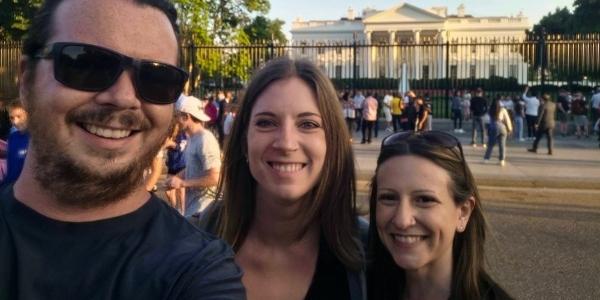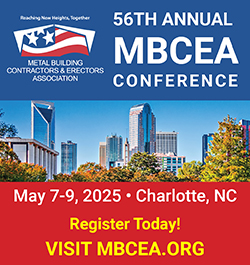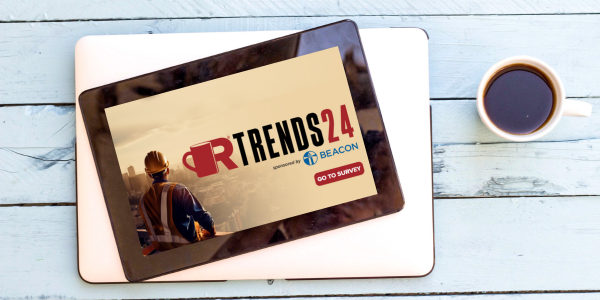UP TO THE MINUTE
Exploring our nation’s capital one memorial at a time

We walked up, down and around Washington, D.C. learning about its architecture, restoration and the people and wars that built our nation.
Editor’s note: The following is a transcript of a conversation the Coffee Shop crew had after the 2024 architectural tour after Roofing Day 2024.
James Ellsworth: We started the day with a brief tour of the National Roofing Contractors Association (NRCA) Washington office, from Deb Mazol, Duane Musser and Teri Dorn. We had about 15 other roofing members who joined us for the architectural tour. It was led by Julie Butler from The Durable Slate Company. That tour started on the march that the British took to burn down the Capitol in 1814, which is very interesting, before there were any other houses except for one house which is now the national women's vote house, I believe.
Lauren White: Someone in the group joked, “The roofers are coming.”
James Ellsworth: Our first official stop was at the Supreme Court building with a clay roof and it cost $9 million dollars, but it came in under budget and early. When you compare that to the Library of Congress building, which was built some 30 if not 40 years prior, which cost $75 million, it’s a really interesting juxtaposition. We then worked our way to talk about the Capitol a little bit and walked to the south side of the Capitol and saw the porch and the doors that the President would walk out of when the President is inaugurated. And then the three of us, that's James, Lauren and Dani, split off to go catch our tour of the Capitol building from representative Salinas’ office.
Lauren White: When we started the walking tour, Julie was talking about the statue named Freedom, located on top of the Capitol building, and that was designed and the model for it was made in Italy. The only people who were doing statues at the time were Italians. Then they sent the model to the U.S. to a Washington sculptor and slave owner. And an enslaved person worked on the statue named Freedom for 10 years.
James Ellsworth: Philip Reid was the enslaved man's name. He worked on casting that mold for 10 years out of bronze and was freed shortly after the completion of the statue, then was never heard from again.
Lauren White: And the statue also has a sword not pointing to anyone, suggesting she is prepared to protect the nation. There's a sword and a shield. And they also wanted a Native American headdress on the top to signify the roots of America as opposed to the Liberty cap which was a symbol of freed slaves. But, from what we learned, they only had one photo to go from that was in a library book in Italy. And since they had never seen a Native American headdress before, it's an eagle head with extra feathers going down the headdress, not necessarily a traditional headdress. It stands 19 feet six inches tall.
James Ellsworth: And it sits on the dome of the Capitol, which is entirely made out of cast iron, which is not the lightest material to make it from. It comes in at a slim nine million tons of which, later during our tour of the Capitol, we were able to stand in the crypt of the capital which holds those nine million tons over your head on very old pillars.
And we had a great tour thanks to Representative Salinas' staff intern and her receptionist Adriana. And it was an hour and a half. A lot of time with them.
 Dani Sheehan: We also saw the rotunda in the Capitol, which is astonishing. I mean, you think about it was obviously taken from ancient Roman and Greek inspiration. And so, you look up and see this painting you half expect is by Michelangelo, but it's George Washington staring down at you and you're like, oh, that's incredible.
Dani Sheehan: We also saw the rotunda in the Capitol, which is astonishing. I mean, you think about it was obviously taken from ancient Roman and Greek inspiration. And so, you look up and see this painting you half expect is by Michelangelo, but it's George Washington staring down at you and you're like, oh, that's incredible.
And particularly hearing the history Adriana gave us, George Washington did not want to be immortalized; he was not an icon. He very firmly believed that he was coming from Britain to this free nation and didn't want it to be this big deal that he was the figurehead in any way. And so, it was cool to hear her explain that and still be like, but he's the founding father. And so obviously we want to represent him and celebrate the founding of our nation. And within the rotunda, besides the ceiling being an incredible painting...
James Ellsworth: ...You have six other paintings of different points in history. And then you also have several statues. And then you have a middle band around the rotunda about halfway up and it gives a particular history, not necessarily in chronological order, we have a certain point of view of the history. The artist of which died in the process of putting it together after having a fall and then a heart attack, so his assistants finish the work for him. And it shows a selective timeline from Columbus finding America until the Wright brothers.
Lauren White: And then also the statue of Martin Luther King Jr., is in there and can't be removed unless an act of Congress were to be passed. Same with Rosa Parks, which was in the old house room. But there those are the only two statues that are not affiliated with any state.
 James Ellsworth: Then we went to the old Supreme Court chambers, where I saw my great uncle's bust. Oliver Ellsworth. I knew that he was involved in the writing of the Constitution. I knew that he had been ambassadors in the polling in France. I did not realize he had a bust in the Capitol. I didn’t realize he was a Supreme Court justice, which is a big deal.
James Ellsworth: Then we went to the old Supreme Court chambers, where I saw my great uncle's bust. Oliver Ellsworth. I knew that he was involved in the writing of the Constitution. I knew that he had been ambassadors in the polling in France. I did not realize he had a bust in the Capitol. I didn’t realize he was a Supreme Court justice, which is a big deal.
Lauren White: And we saw the original clock that was in there. It is set five minutes fast to keep things going and on track.
James Ellsworth: And now I found that really, really interesting because there was very little natural lights but because it was in the basement it was also cool. In DC in the summer, it would be a very valued place to be.
Lauren White: They also have it dark because that's originally how dark it would have been given the lanterns and the candles they had.
Dani Sheehan: We did see the original cornerstone of the Capitol that was laid by George Washington. And there was a plaque there that was a replica because they lost the original. It was donated for the 100-year celebration. And it was a pure silver plaque. And to this day, we don't know where it is.
James Ellsworth: And this should be National Treasure 3.
Dani Sheehan: Oh, let’s talk about the modern air conditioning. There were literal vents in the floor. And the thought was that they put giant ice blocks in the bottom with fans to help cool the hallways of the Capitol building. Prior to air conditioning I can't imagine how badly that place smelled with all those men who smoked and chewed tobacco and spit it everywhere.
 James Ellsworth: We saw spittoons in the old Senate's room. Where they also kept the spare desks. All the original Senate desks are still in the current Senate chambers, but they have several replicas in the old Senate chambers for when a desk needs to be repaired, they can just swap it out.
James Ellsworth: We saw spittoons in the old Senate's room. Where they also kept the spare desks. All the original Senate desks are still in the current Senate chambers, but they have several replicas in the old Senate chambers for when a desk needs to be repaired, they can just swap it out.
Lauren White: Yes, and then from there we went to the old House Chambers, now Statutory Hall, where Rosa Parks statue is and there are plaques on the floor for where people had their desks placed.
Dani Sheehan: And Abraham Lincoln was unhappy with his desk placement because it was too cold, and he couldn't hear because it was too far away to hear the speakers.
Lauren White: And there's a definite echo in there, so it's easy to understand why it was so hard for him to hear.
James Ellsworth: Our valiant guides attempted to get us a view of the speaker's balcony. Unfortunately, only GOP members were allowed in, so we were unable to visit such an esteemed place.
Lauren White: We then went back through the tunnels. These two went out of their way to take us through all the tunnels to the Madison Building of the Library of Congress and to the cafe to have lunch. And it's on the sixth floor, so we had a great quiet lunch with a view and then we started our own walking tour.
Dani Sheehan: We walked over 11 miles through the entire mall of DC, 27,400 steps.
James Ellsworth: We went from the Capitol building through a bit of the Botanical Gardens. So beautiful. So many wonderful varieties of plants and species from around the world were there and it was just so nice seeing so much green and color in the middle of such a big bustling city.
Dani Sheehan: Yeah, we were literally steps away from the street, but it felt like as soon as you walked into the gardens there was calm, there was quiet. 
James Ellsworth: We saw an urban agricultural garden area with food that you can harvest – garlic, strawberry, lettuces and chard and all sorts of stuff was growing, which was cool to see.
Then we made our way to the castle gardens. We had a brief detour to Europe at The Smithsonian Castle that is currently under renovation, so we couldn’t go inside.
Dani Sheehan: The Castle has Moorish influences. And one of the four gardens has Spanish influence from the fountain and the design to the layout. And they had another great variety of plants. And there was one particular flower that looks like candy cane!
Lauren White: And then we made our way to the Washington Monument and marveled at the size of the blocks. And it weighs roughly the same amount as 6,500 school buses. It is 555 feet tall, which when it was built was the tallest building in the world, it isn’t anymore.
 And the view from up there is gorgeous. Perfect day, tons of people out, tons of eighth grade field trips and families everywhere. We went from the Washington Monument over to the World War II Memorial.
And the view from up there is gorgeous. Perfect day, tons of people out, tons of eighth grade field trips and families everywhere. We went from the Washington Monument over to the World War II Memorial.
James Ellsworth: All of the memorials are very well done. Very moving. They hit you. They really want you to sit with it for a little bit. The World War II memorial is very, very well done. They have a plaque at the back with gold stars.
There were 4,048 stars on a placard, and each one represents 100 American fallen soldiers for almost half a million fallen soldiers. And that was completed in 2005. From there we went to the Vietnam Memorial, which is always really powerful.

Dani Sheehan: I don't have a lot of personal family history with veterans and with the various wars. I'm familiar with some of the history but walking into the Vietnam Memorial was really, really cool. There were a lot of eighth-grade students and getting to overhear the kids looking for names that they had been assigned, and they had printouts of information about these particular soldiers, which was honestly just so inspiring. And it was so cool to feel the respect that came from, you know, kids that are 13 years old, and they took their job very seriously in finding these names on the wall,
Lauren White: And we saw another group too. We saw a lot of people walking with veterans around the memorial, and we got curious, so we asked one of the Guardians, as they call themselves, and found out they’re part of an organization called the Honor Flight. They're based out of Ohio, they have multiple locations, but they take veterans and do completely free tours of the memorials. And two veterans are assigned to one Guardian, and this woman that we spoke with from Ohio told us they do nine trips a year, all one-day trips, completely free. And the group, which is nonpartisan, and they don’t accept any federal funding, takes care of everything financially, the transportation, the day-of logistics.
The Guardians pay for their p ortion of the trip themselves, and they just make it a great respectful day for whatever the veterans want and need. And they were all looking for their fallen brothers.
ortion of the trip themselves, and they just make it a great respectful day for whatever the veterans want and need. And they were all looking for their fallen brothers.
Dani Sheehan: That was the part that was the hardest to see. Now elderly individuals, looking for the names of their buddies on the wall.
James Ellsworth: So we spent a lot of time there, which was great. It's also when we happened to spot a Marine One drop off, which was very cool to see Marine One fly overhead and land at the White House lawn. And then leave a little bit after it dropped off. There had been a lot of air traffic, a lot of secret service on the bikes in the mall and a lot of helicopters leading up to that.
After that, we went to the Lincoln Memorial, which is also under construction. They are doing some renovations and updates. But it's open and it's always really nice to be able to read his Gettysburg Address on one side and on the other side his second inaugural address.
We found today that a lot of the quotes and a lot of the writings that had been etched in stone all those years ago, are very poignant in today's climate. So, after a little bit of time there we continued on our way to the Korean War, which had just recently been updated two years ago we discovered.
 Lauren White: Also very powerful, and that's one that I vividly remember from my eighth-grade field trip here. Those life size, larger than life size, statues of the troops walking through the field, which are dedicated to the field squads. And just, the wall of the faces staring back at you and all of the names listed out of the fallen soldiers, is again, very powerful.
Lauren White: Also very powerful, and that's one that I vividly remember from my eighth-grade field trip here. Those life size, larger than life size, statues of the troops walking through the field, which are dedicated to the field squads. And just, the wall of the faces staring back at you and all of the names listed out of the fallen soldiers, is again, very powerful.
James Ellsworth: I haven't realized this but they delineated the fallen soldiers by branch and there's I think 90 or so panels, each one with about 400 names on it. And I'd say 75 were for the Army, and then the remainder or for a combination of the Marines, Navy and the Air Force. And that was surprising to me to see such a massive contingent of that in the Army side, not that it's uncommon, but how many of them were privates.
Dani Sheehan: And it was just so powerful. We were there at such a unique time of day where we kind of missed the crowd. And it was so quiet and so serene. I remember seeing a couple sitting on a bench staring in silence. And I'm assuming he was a veteran, I can't say that for sure, but just getting to be a part of that and feel that energy and really embrace what these memorials are about, was so cool, particularly as an adult, when I haven't been back in years.
James Ellsworth: The statutes are so well done, they're almost human size, but they're just 10% bigger, so you just feel dwarfed by them.
Lauren White: And the faces are so detailed and haunting, they somehow captured that. There’s so much attention to detail. You see the antennae on the radios, the detail of the guns they’re holding and the ponchos draping over their gear, it was just incredibly well done and the looks on their faces really stick with you.

From there, we made our way to the MLK Memorial, which is newer and none of us have ever been to. It was very moving and included a lot of great quotes, many of which we hadn’t heard or read before.
James Ellsworth: How they did the entrance was so cool. They had this mountain of marble and then the middle part is cut out and pushed forward and that's what the statue of Martin Luther King Jr. is carved from.
Dani Sheehan: On the side of the center of the mountain that was pushed forward, the quote, “Out of the mountain of despair, a stone of hope.” And it was exquisite, very powerful overlooking the Tidal Basin.
James Ellsworth: But the quotes around the memorial were just so well thought out, and there was a chronology again, and it delineated where MLK was in his career at the time, based on what was happening in society, a few of which I was unfamiliar with. And a number of which that we're very, very poignant right now in this time. 
Lauren White: And the trail continued to the Franklin Delano Roosevelt Memorial.
James Ellsworth: My personal favorite memorial, while it's a long one, has four or five distinct sections. There's a smaller one at the beginning and the others go through each of his terms through the depression, the New Deal, the statues standing in the breadlines, the statue of a person listening to his fireside chats. And the President's quotes on the environment, social justice and equity all throughout were well thought out.
Dani Sheehan: And the entire Memorial is based around water. So you have your four rooms representing the four terms, but you also have a signature water piece that is just so symbolic of the movement that FDR promoted, from his first term to his final one where they're rebuilding the world order in a very unstable way.
I think my favorite part though is the Eleanor section, because it shows her being the first delegate to the United Nations. Every time I see that I always forget. And it's such a wonderful thing that she was there and she championed the Charter of Human Rights. We have a lovely selfie with her statue and a great selfie with the pup, Fala.
 Lauren White: And then we made our way to the Jefferson Memorial. There was construction there also, improving the electrical and plumbing and accessibility to the memorial.
Lauren White: And then we made our way to the Jefferson Memorial. There was construction there also, improving the electrical and plumbing and accessibility to the memorial.
James Ellsworth: We had a great time at the memorial, reading the quotes – one quote in each of the cardinal directions around him. They were all very good, he was an amazing writer.
Lauren White: Then we found our way to the White House and got to see it as the sun was setting. And we finished our night with sushi dinner and...
James Ellsworth: ...a final stop at Old Ebbit Grill, which is an old haunt I've been told about that many White House staffers and folks from the military go there to talk and figure things out.
Lauren White: And we say goodbye tonight and fly out tomorrow and get back at it next week. We'll be here again next year.
Dani Sheehan: Such an incredible experience. And I'm so honored to work for the roofing industry. It's really nice to work for an industry with such solid values and approachable people that make you want to continue to make not only the industry better, but the country better too.
Stay up to date with the latest industry news when you sign up for the Coffee Shop eNews.




















Comments
Leave a Reply
Have an account? Login to leave a comment!
Sign In